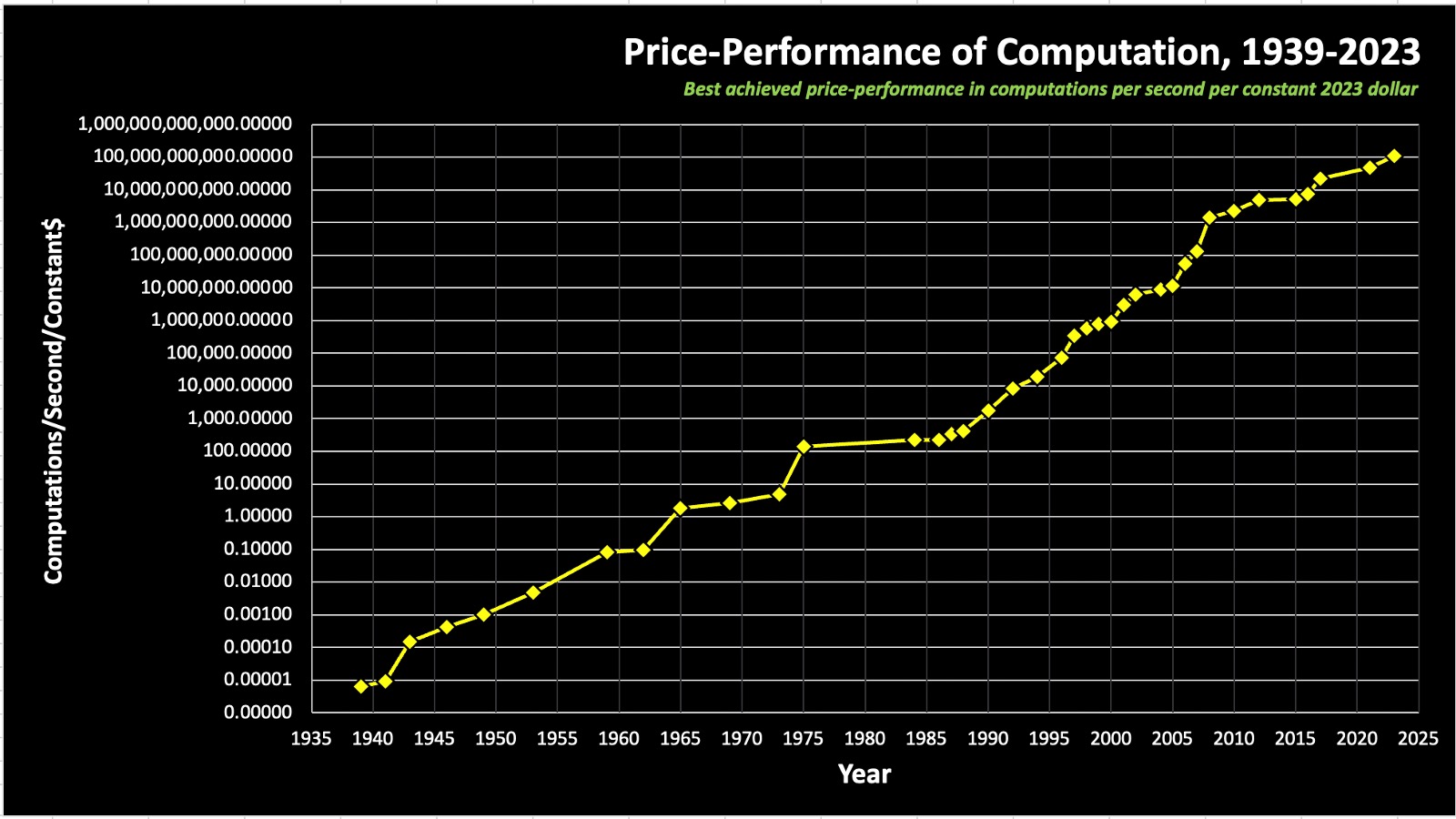The Price of Intelligence
"The future is already here – it's just not evenly distributed."— William Gibson

We find ourselves in a world of exponentially growing intelligence. What has struck me about the AI revolution is not just its unprecedented explosion in capability, but the recognition that we have always been on this trajectory of exponential intelligence growth. While we commonly recognize this pattern in our technology—from the price-to-performance improvements in computation to the accelerating pace of technology adoption—this same pattern has been quietly shaping human cognitive evolution across generations.
Looking back through history, this intelligence growth was initially imperceptible, much like the early stages of any exponential curve. For millennia, the line appeared essentially flat, with only minute improvements from one generation to the next. But as with all exponential growth, the subtle accumulation eventually reaches a tipping point. We began to notice how each generation built upon the knowledge of the last, with technological advances accelerating this progression. Each new insight unlocked further technological possibilities, creating a self-reinforcing cycle of advancement.
To understand where we are heading, consider the evolution of Moore's Law. Gordon Moore at IBM observed that the number of transistors on a chip doubled every couple of years, predicting this trend would continue. When physical limitations threatened to end this progression—as transistors couldn't get infinitely smaller—the industry made a leap. Instead of just packing more transistors onto chips, we developed new approaches: multiple processor cores, GPU parallelization, and novel architectures. Moore's Law, in essence, transcended its original context to reveal a deeper truth about technological progress itself.
Ray Kurzweil recognized this broader pattern in his 1990 book "The Age of Intelligent Machines" and later in his influential 2005 work "The Singularity is Near." His predictions about technological advancement have proven remarkably accurate, with a success rate around 85%. But I believe even Kurzweil's technological growth model is just one facet of an even larger phenomenon—the exponential growth of intelligence itself.
We are now witnessing a momentous jump in this progression as we transition from human to artificial intelligence. The exponential growth of technology has become inextricably linked with AI advancement. Computing power, hardware performance, and software capabilities are all being channeled into artificial intelligence development. Like computation before it, the cost of intelligence is plummeting—in theory, approaching zero. However, this theoretical democratization of intelligence masks a troubling reality.
This pattern of consolidating and monetizing access to transformative technology isn't new—we saw it with early computing, with the internet, and now with AI. But this time the stakes are higher, because we're not just gating access to information or tools, but to intelligence itself. Paradoxically, even as AI capabilities soar, the price of accessing intelligence is rising for many. The shift from print to digital media, the evolution of social platforms, and the commercialization of AI have all contributed to this trend. What began as open platforms promising equal access to intelligence are increasingly hidden behind expensive paywalls. OpenAI's trajectory is emblematic: in just two years, they've gone from an open platform to a tiered subscription model costing up to $200 monthly for premium access.
This creates a widening intelligence gap that parallels and potentially amplifies existing wealth disparities. We're witnessing the emergence of a new divide between those who can afford access to advanced AI capabilities and those who cannot. Throughout history, in both human civilization and the natural world, competitions between groups with disparate intelligence levels have consistently favored the more intelligent. This pattern raises profound questions about the social implications of AI accessibility and the future of human society.
AI Capability Gaps Across Different Benchmarks
GPQA Diamond
HumanEval
Codeforces Rating
Each benchmark reveals different aspects of the capability gap between tiers. GPQA Diamond shows the largest relative gap in general intelligence and scientific reasoning. HumanEval shows smaller but significant improvements in basic coding capability. Codeforces ratings demonstrate increasing sophistication in complex programming tasks, with the Pro tier reaching Candidate Master level.
The implications of this intelligence gap extend far beyond just who can access the latest AI tools. As these systems become more capable, they will increasingly influence decision-making, creativity, and problem-solving across every domain. Those with full access will essentially have a cognitive multiplier that others lack. For the first time in history, we face the prospect of human intelligence becoming a tiered service—a transformation that could reshape the very fabric of human society.
The challenge before us is not just about managing artificial intelligence's capabilities, but ensuring its benefits don't become concentrated in the hands of a privileged few. The democratization of intelligence may be technically possible, but without careful consideration and deliberate action, we risk creating an unprecedented divide in human capability—one that could prove far more consequential than any technological gap that has come before.




